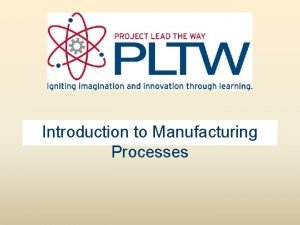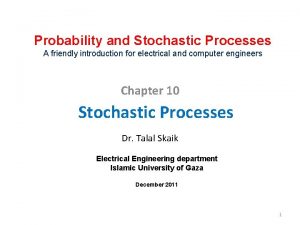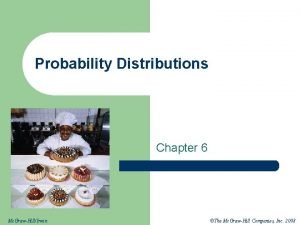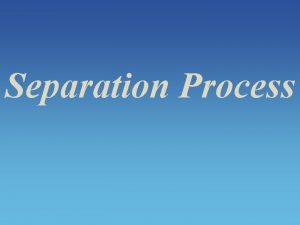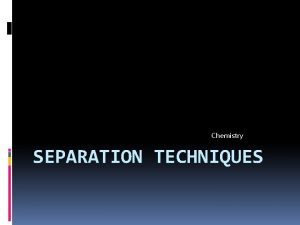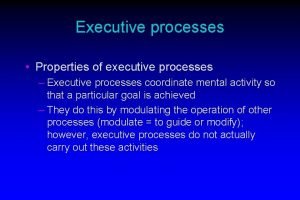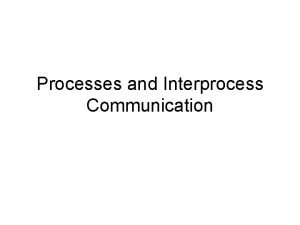Introduction to Separation processes There are five separation

















- Slides: 17

Introduction to Separation processes Ø There are five separation techniques used in the separation processes: 1. Phase Creation: Use ESA (heat or depressurize) 2. Phase Addition: Use MSA (add solvent, liquid absorbent) 3. Barrier Separation: Use membrane (semipermeable membrane) 4. Solid Agent separations: Use particles (reaction, absorbent film, direct absorption, chromatography) 5. Separation by gradient: Use electric field, magnetic field, gravity (electrophoresis, mass spec) Ch. E 334: Separation Processes Dr Saad Al-Shahrani

Introduction to Separation processes Ø All five techniques relay on the ability to enhance the rate of mass transfer of certain species relative to others to effect a spatial separation of components. Ø Thus, all separations processes must introduce a thermodynamic driving force to overcome the decrease in the entropy of the system as the components are separated. Ch. E 334: Separation Processes Dr Saad Al-Shahrani

Introduction to Separation processes Ø Separation by phase creation or addition: § This technique is based on the creation or addition of second phase (vapor, liquid or solid) that is immiscible with the feed phase. Phase 1 Feed Phase Creation Phase Addition M. S. A Phase 2 (E. S. A) Ch. E 334: Separation Processes Phase 2 (M. S. A) Dr Saad Al-Shahrani

Separation by Phase Creation or Addition § If the feed mixture is a homogeneous, single-phase solution (gas, liquid or solid), second immiscible phase must be created or added before separation of chemical species can be achieved. § The second phase is created by an energy-separating agent (ESA) and second phase can be added using massseparating agent (MSA). § (MSA) → (add solvent, liquid absorbent) § (ESA) → Heat added or heat removed, other separating agent can be used such as pressure reduction and work transfer. Ch. E 334: Separation Processes Dr Saad Al-Shahrani

Separation by Phase Creation or Addition Ø Separations that use an (ESA) are generally preferred, while (MSA) can make separation possible when it is not feasible with an (ESA). Ø Disadvantages of the use of an MSA are: 1. Need for an additional separator to recover the MSA for recycle. 2. Need for MSA makeup. 3. Possible contamination of the product with the MSA. 4. More difficult design procedures. Ch. E 334: Separation Processes Dr Saad Al-Shahrani

Separation by Phase Creation or Addition Ø When two immiscible fluid phases are contacted, intimate mixing of the two phases is important in enhancing mass transfer rates so that thermodynamic-maximum degreeof-partitioning of species can be approached more rapidly. Ø After phase contact, the separation operation is completed by employing gravity and/or an enhanced technique, such as centrifugal force, to disengage the two phases. Ch. E 334: Separation Processes Dr Saad Al-Shahrani

Separation by Phase Creation or Addition 1. Partial condensation or vaporization: ( When the feed mixture includes species that differ widely in their tendency to vaporize and condense) Vapor Initial or feed phase vapor or Liquid Created phase Liq. vapor or Liquid Or vap. Cooling or heating Separating Agent Heat transfer (ESA) liquid e. g : Recovery of H 2 and N 2 from NH 3 by partial condensation and high pressure phase separation. Ch. E 334: Separation Processes Dr Saad Al-Shahrani

Separation by Phase Creation or Addition 2. Flash vaporization ( By reducing the pressure of the feed with a valve) Initial or feed phase Liquid vapor Created phase Liquid vapor Drum pressure reduction Separating Agent Pressure reduction (ESA) liquid e. g : Recovery of water from sea water (Desalination). Ch. E 334: Separation Processes Dr Saad Al-Shahrani

Separation by Phase Creation or Addition 3. Distillation Initial or feed phase (When volatility differences among species in the feed are not sufficiently large) Liquid and /or vapor L Created phase Vapor and liquid V/L Separating Agent Heat transfer (ESA) L e. g : Separation of benzene and toluene. Ch. E 334: Separation Processes Dr Saad Al-Shahrani

Separation by Phase Creation or Addition 4. Extractive Distillation Initial or feed phase (When volatility differences between species to be separated are so small as to necessitate more than about 100 trays in a distillation operation) Vapor and/or liquid Created phase MSA L Vapor and liquid Separating Agent V/L Liquid solvent (MSA) and heat transfer (ESA) L e. g : Separation of acetone and methanol. Ch. E 334: Separation Processes Dr Saad Al-Shahrani

Separation by Phase Creation or Addition 5. Liquid – liquid extraction (when distillation is impractical, especially when the mixture to be separated is temperature-sensitive and/or more than about 100 distillation stages would be required) Initial or feed phase L liquid MSA Created phase liquid Separating Agent (One solvent or two solvents) Liquid solvent (MSA) L L e. g : Recovery of aromatics. Ch. E 334: Separation Processes Dr Saad Al-Shahrani

Separation by Phase Creation or Addition 6. Absorption V Initial or feed phase (If the feed is all vapor and the stripping section of the column is not needed to achieve the desired separation) Vapor MSA Created phase liquid Separating Agent Liquid absorbent (MSA) V L e. g : Separation of CO 2 from combustion products by absorption with aqueous solutions of an ethanolamine. Ch. E 334: Separation Processes Dr Saad Al-Shahrani

Separation by Phase Creation or Addition 7. Drying (involves removal of a liquid from a solid by vaporization of the liquid) Initial or feed phase Liquid and often solid Created phase vapor Phase created V L/S (ESA) + (MSA) V (hot gas) Separating Agent Gas (MSA) and or/ heat transfer (ESA) S Feed e. g : Removal of water from polyvinylchloride with hot air in a fluid-bed dryer. Ch. E 334: Separation Processes Dr Saad Al-Shahrani

Basic Description of operations 8. Stripping (A liquid mixture is separated, generally at elevated temperature and ambient pressure, by contacting liquid feed with a stripping agent) L V Initial or feed phase liquid Created phase vapor Separating Agent MSA Stripping vapor (MSA) L e. g : Stream stripping of naphtha, kerosene, and gas oil side cuts from crude distillation unit to remove light ends. Ch. E 334: Separation Processes Dr Saad Al-Shahrani

Separation by Phase Creation or Addition 9. Reflux stripping (steam distillation) (If contacting trays are also needed above the feed tray in order to achieve the desired separation) Initial or feed phase L/V Vapor and/ or liquid Created phase MSA V/L Vapor and liquid Separating Agent MSA Stripping vapor (MSA) and heat transfer (ESA) L e. g : Separation of products from delayed coking. Ch. E 334: Separation Processes Dr Saad Al-Shahrani

Separation by Phase Creation or Addition 10. Re-Boiled stripping (If the bottoms product from a stripper is thermally stable, it may be reboiled without using an MSA) V Initial or feed phase liquid L Created phase vapor Separating Agent Heat transfer (ESA) L e. g : Recovery of amine absorbent. Ch. E 334: Separation Processes Dr Saad Al-Shahrani

 Antigentest åre
Antigentest åre Concurrent processes are processes that
Concurrent processes are processes that Describe in brief the various methods of size separation
Describe in brief the various methods of size separation The sounding cataract haunted me
The sounding cataract haunted me One in five challenge
One in five challenge 5 senses and 5 elements
5 senses and 5 elements Drum and colors macbeth
Drum and colors macbeth Introduction to manufacturing process
Introduction to manufacturing process Introduction to stochastic processes pdf
Introduction to stochastic processes pdf There are five types of
There are five types of There were 5 in the bed
There were 5 in the bed There are five flights daily from pittsburgh
There are five flights daily from pittsburgh Show that there are exactly five 3 digit cube numbers
Show that there are exactly five 3 digit cube numbers There is there are ejemplos
There is there are ejemplos What part of speech is open
What part of speech is open There is there are negative form
There is there are negative form There are there is
There are there is There aren't some cakes
There aren't some cakes







